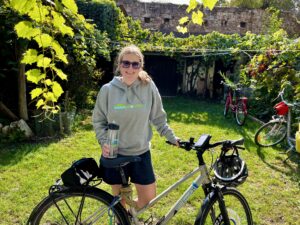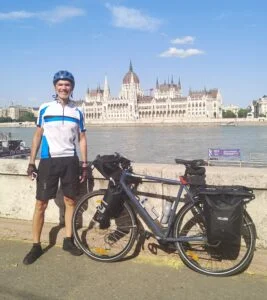 You may have heard the term bikepacking used with increasing frequency over the years. Bikepacking, a combination of backpacking and bike touring, is often used interchangeably with bicycle touring. While those who use bikepacking and bike touring interchangeably aren’t wrong, they aren’t always right either.
You may have heard the term bikepacking used with increasing frequency over the years. Bikepacking, a combination of backpacking and bike touring, is often used interchangeably with bicycle touring. While those who use bikepacking and bike touring interchangeably aren’t wrong, they aren’t always right either.
The term bikepacking emerged in the early 2000s to describe a type of bicycle touring that emphasizes lightweight gear and off-road travel. Bike touring becomes bikepacking when the route veers off the well-traveled roads we all stuck to in the pre-GPS era. But now that we all have smartphones more powerful than a 90s computer and modern lightweight backpacking gear, we can confidently stray farther off the beaten path. Hence, bikepacking.
If we use this definition of bikepacking, all bikepacking is inherently bike touring, but all bike touring isn’t necessarily bikepacking. Bike touring? Bikepacking? They’re both valid methods of adventure by bike and pretty similar when you get down to it.
Call it what you want. Whether bicycle touring, bikepacking, or a little bit of both, you’ll have an unforgettable time. But there are subtle differences between them.
Bicycle Touring: The Original Bike Travel
Bicycle touring is the traditional method of bicycle travel. It’s more oriented toward riding paved roads and highways. Touring bikes are similar to road bikes but usually have bigger tires. Touring cyclists often carry their gear using racks and panniers.
Bike touring is great. Navigation is easy, and pedaling on graded paved roads is generally less challenging than dirt roads or singletrack.
However, no one will stop you from touring with a rack and panniers on dirt roads. You can ride on dirt with a bike touring setup. But if you plan to ride a lot of dirt and gravel, you may want to go lighter. Lightweight gear will make that challenging terrain easier. This is where bikepacking comes in, with a focus on cutting weight to make off-highway travel easier.
Bikepacking: More Off-Road, Less Gear
Bikepacking routes are usually more off-road focused and only use paved roads to connect more remote roads and trails. If you want to get farther out there, bikepacking will get you there.
Bikepacking bikes are often mountain bikes, but sometimes they have road bike-style drop handlebars with bigger tires. Bikepacking cyclists usually carry their gear in bags strapped to the bike without racks.
Bicycle Touring Bikes and Gear
A typical bike used for bicycle touring is a “touring bike.” The bike industry has a specific kind of bike they make for bicycle touring—it has drop bars, lower gearing, mounts for racks and panniers, and can fit bigger tires than a road bike. Most touring bikes are also made of steel for comfort and durability.
But not all touring bikes have drop bars. Not all touring bikes are steel, either. Nor do they all have room for large tires, racks, and panniers. The bike you’re riding while bicycle touring is a touring bike.
Bike touring gear can vary, as you know, but a traditional bike touring setup uses a front and rear rack with panniers. Most touring cyclists also use a small to medium-sized handlebar bag with a map holder on top.
Fully loaded bike touring uses four panniers, two strapped to a rear rack and two more attached to a fork-mounted front rack. This setup allows you to carry a lot of gear. The average pannier is approximately 15 liters, so you have a 60-liter volume capacity with four panniers. That’s as large as most backpacking backpacks.
Touring bike tire size depends on the length of the trip, the types of roads expected, and personal preference. Generally speaking, since bike touring sticks to better roads, you don’t need quite as large of tires as you would when bikepacking. However, there are plenty of touring bikes with wider tires than an average mountain bike.
Bikepacking Bikes and Gear
Since bikepacking routes tend to stay away from pavement, most bikepacking bikes are mountain bikes. They can be hardtails, full-suspension, or fully rigid, but bikepacking bikes are often some kind of mountain bike.
Gravel bikes, cyclocross, or off-road touring bikes are also used for bikepacking. If you’re strapping bags to your frame and riding on dirt roads, gravel, and singletrack, call it a bikepacking bike.
Most bikepacking bags are durable stuff sacks designed to fit onto a specific location of a bike. A handlebar bag goes on the handlebars, a frame bag in the center triangle, and a saddle bag below the saddle. Space is limited in these bags, so ultralight is a must. A typical bikepacking handlebar bag, saddle bag, and frame bag combine to be about 35 liters of space.
Bikepacking handlebar bags are long and narrow stuff sacks that strap tightly to the handlebars. These handlebar bags have a secure mounting system and are much larger than a bicycle touring handlebar bag.
The seat bags used for bikepacking are conical-shaped stuff sacks with straps that attach to a bike’s saddle rails and seatpost. This bag is much larger than the small saddle bag for storing tools and a flat repair kit. This seat bag usually holds most of one’s camping gear.
A frame bag fits into the bike’s center triangle and usually has a zipper opening. If you compare a “bikepacking bike” with a “touring bike,” the most apparent difference will likely be a frame bag.

 Bike Touring and Bikepacking Pros and Cons
Bike Touring and Bikepacking Pros and Cons
Bikepacking and bicycle touring are both great. And frankly, there’s enough overlap between them that you shouldn’t spend too long dwelling on which is superior. However, there are some pros and cons to each.
Bike touring is better if you want to carry a lot of food or gear. It’s more popular for multi-month tours for this reason. It’s also easier to pack gear into panniers, which also makes it popular for long trips. With bike touring, packing in the morning is as simple as throwing gear into panniers and attaching them to racks. It’s more complicated with bikepacking bags.
Regarding food, bicycle touring can allow you to eat a wider variety of food and be less expensive than bikepacking. Four panniers can fit a lot, so you can go farther between resupplies. This means you don’t have to resupply at every gas station or expensive small-town grocery store you see when bicycle touring. When cramming all your food into a single-frame bag, you’re probably stopping as often as possible to resupply.
Bikepacking has its benefits, too. Bikepacking is great for short and fast trips through rugged terrain.
Bikepacking setups are usually much lighter, which makes riding more fun. The combination of smaller bags, fewer bags, and no racks makes a bikepacking rig feel more nimble than a fully loaded touring bike, and a lighter bike makes covering ground easier. Not having panniers makes your bike fit in tight spaces, meaning you can ride single-track or bring a bikepacking rig in places you’d never attempt with a fully loaded touring bike, like your Warmshowers host’s small apartment. Sorry about the dirt!
So What’s The Difference?
Whether it’s bikepacking or bicycle touring, it’s all adventure by bike.
There are differences, but there’s a lot of overlap between bicycle touring and bikepacking. You can use panniers when bikepacking or a frame bag when bicycle touring. No one is going to stop you.
Most of the differences between bike touring and bikepacking are in how you approach traveling by bike. Are you going fast and light, or are you in it for the long haul? Do you want to split hairs making somewhat arbitrary distinctions, or would you rather get back to pedaling? That’s up to you!






